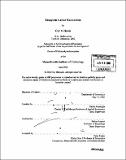| dc.contributor.advisor | Daron Acemoglu and Joshua Angrist. | en_US |
| dc.contributor.author | Michaels, Guy, Ph. D. Massachusetts Institute of Technology | en_US |
| dc.contributor.other | Massachusetts Institute of Technology. Dept. of Economics. | en_US |
| dc.date.accessioned | 2006-11-07T12:33:27Z | |
| dc.date.available | 2006-11-07T12:33:27Z | |
| dc.date.copyright | 2006 | en_US |
| dc.date.issued | 2006 | en_US |
| dc.identifier.uri | http://hdl.handle.net/1721.1/34501 | |
| dc.description | Thesis (Ph. D.)--Massachusetts Institute of Technology, Dept. of Economics, 2006. | en_US |
| dc.description | Includes bibliographical references. | en_US |
| dc.description.abstract | My dissertation is a collection of three essays that consider various aspects of income inequality and the demand for skill. The first chapter uses the advent of the US Interstate Highway System to examine the effect of reducing trade barriers on the relative demand for skilled labor. The Interstate Highway System was designed to connect major cities, to serve national defense, and to connect the US to Canada and Mexico. As an unintended consequence, many rural counties were connected to the highway system. I find that these counties experienced an increase in trade-related activities, such as trucking and retail sales. By increasing trade, the highways raised the relative demand for skilled manufacturing workers in skill-abundant counties and reduced it elsewhere, consistent with the predictions of the Heckscher-Ohlin model. The second chapter examines the effect of the division of labor on the demand for information processing. I find that manufacturing industries with a more complex division of labor employ relatively more clerks, who process information that is used to coordinate production. An early information technology (IT) revolution that took place around 1900 raised the relative demand for clerks in manufacturing, and significantly more so in industries with a complex division of labor. | en_US |
| dc.description.abstract | (cont.) The increased demand for clerks likely contributed to the subsequent onset of the High School Movement. Interestingly, recent changes in IT have enabled firms to substitute computers for clerks, and I find evidence that this substitution occurred at a faster rate in more complex industries. The third chapter, coauthored with Liz Ananat, examines the effect of marital breakup on the economic outcomes of women with children. We find that having a female firstborn child increases the probability that a woman's first marriage ends in divorce. Using this exogenous variation we find that divorce has little effect on a woman's average household income, but it does increase the probability that her household ends up in the lowest income quartile. While women partially offset the loss of spousal earnings by receiving more child support and welfare, combining households, and increasing their labor supply, divorce still increases the odds of household poverty. | en_US |
| dc.description.statementofresponsibility | by Guy Michaels. | en_US |
| dc.format.extent | 146 p. | en_US |
| dc.format.extent | 7869401 bytes | |
| dc.format.extent | 7877237 bytes | |
| dc.format.mimetype | application/pdf | |
| dc.format.mimetype | application/pdf | |
| dc.language.iso | eng | en_US |
| dc.publisher | Massachusetts Institute of Technology | en_US |
| dc.rights | M.I.T. theses are protected by copyright. They may be viewed from this source for any purpose, but reproduction or distribution in any format is prohibited without written permission. See provided URL for inquiries about permission. | en_US |
| dc.rights.uri | http://dspace.mit.edu/handle/1721.1/7582 | |
| dc.subject | Economics. | en_US |
| dc.title | Essays in labor economics | en_US |
| dc.type | Thesis | en_US |
| dc.description.degree | Ph.D. | en_US |
| dc.contributor.department | Massachusetts Institute of Technology. Department of Economics | |
| dc.identifier.oclc | 70879651 | en_US |
